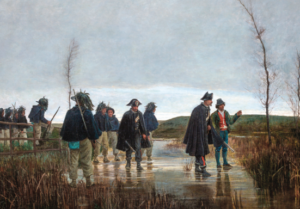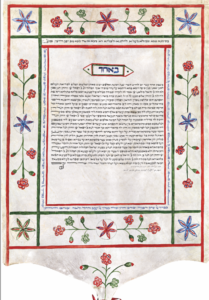Roman Jews from the ghetto to freedom
 A dive into 70 artworks ranging from paintings, sculptures, drawings, engravings, to manuscripts and photographs, accompanied by a sound installation of music composed during the Italian Unification, also known as Risorgimento. Such is the expressive value of “1849-1871. Roman Jews between segregation and emancipation”, the new exhibition of the Jewish Museum in Rome presented on this day to the press and made open to the public starting from tomorrow until next year’s 27 May.
A dive into 70 artworks ranging from paintings, sculptures, drawings, engravings, to manuscripts and photographs, accompanied by a sound installation of music composed during the Italian Unification, also known as Risorgimento. Such is the expressive value of “1849-1871. Roman Jews between segregation and emancipation”, the new exhibition of the Jewish Museum in Rome presented on this day to the press and made open to the public starting from tomorrow until next year’s 27 May.
Curated by Francesco Leone and Giorgia Calò, the exposition uses some borrowings from the most important Italian museums on the Risorgimento and prestigious private collections with the objective of recounting the Jewish effort and involvement in that decisive historical phase for national events. There will be special focus on the reality of Roman Jews, the most ancient of the Diaspora, who obtained freedom only after the annexation to the Kingdom of Italy, after they had been denied it for centuries by the Church.
 Risorgimento and Jews: a deep bond. “It wasn’t a simple and obvious process, but the hopes aroused by the Albertine Statute and the subsequent, albeit not so timely, decrees that conferred equality to the Israelites in the kingdom determined the vast movement of Jewish identification in the national cause and resurgence” recalls rabbi Riccardo Di Segni, head rabbi of Rome. “On the other hand – adds the rabbi – Jewish history became an artistic and spiritual model, for the patriots, as demonstrated by the success of Verdi’s “Va’ pensiero”, which compared the fate of the Jews, unhappy, exiled and deprived of the homeland and that of the Italians, divided and dominated by foreigners.
Risorgimento and Jews: a deep bond. “It wasn’t a simple and obvious process, but the hopes aroused by the Albertine Statute and the subsequent, albeit not so timely, decrees that conferred equality to the Israelites in the kingdom determined the vast movement of Jewish identification in the national cause and resurgence” recalls rabbi Riccardo Di Segni, head rabbi of Rome. “On the other hand – adds the rabbi – Jewish history became an artistic and spiritual model, for the patriots, as demonstrated by the success of Verdi’s “Va’ pensiero”, which compared the fate of the Jews, unhappy, exiled and deprived of the homeland and that of the Italians, divided and dominated by foreigners.
Ruth Dureghello, president of the Roman Jewish community was struck by this wish to claim full italianity. In Italy and particularly in Rome. “The wish for a common homeland – she reflects- was amplified in the Jewish community by the wish for standardisation of rights to every other citizen. The participation in the Risorgimento was also great because of this reason”. This was also shown by one of the most significant documents in the exhibition, a letter of the National Guard to Samuele Alatri “with the request of a Bible for the Jewish soldiers’ oath”.
Alessandra Di Castro, president of the Foundation for the Jewish Museum of Rome: “The Italian and Roman Jews have played a protagonist role in the path of emancipation and freedom of the Risorgimento, which brought them to the full enjoyment of their civil rights and that, together, has led Italians to national unity.
The exhibition, set up under the auspices of the Jewish community of Rome and the foundation for the Jewish Museum of Rome, meets the collaboration of the Department of Heritage and Cultural Activities, with the support of Acea S.p.A, the David Berg Foundation, Ronald S. Lauder and an international philanthropic foundation.
From top, “La perlustrazione” by Alberto Issel (1848-1926) and ancient Ketubah (Jewish marriage contract) preserved in the historic Archive of the Jewish Community of Rome.
Translated by Oyebuchi Lucia Leonard and revised by Gianluca Pace, students at University of Trieste and the Advanced school for interpreters and Translators of the University of Trieste, interns at the newspaper office of the Union of the Italian Jewish Communities.
